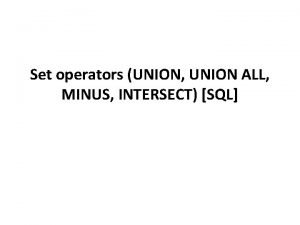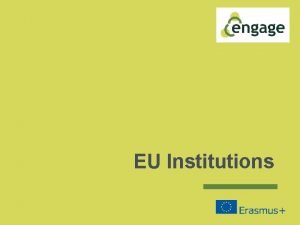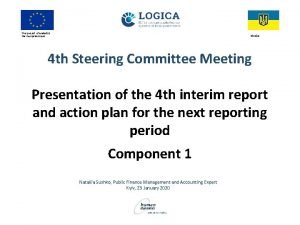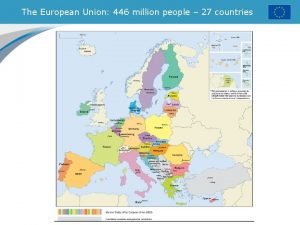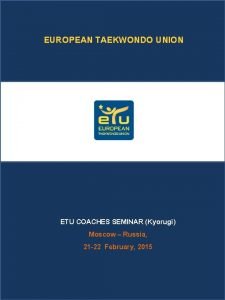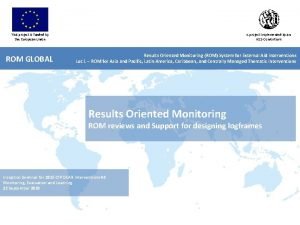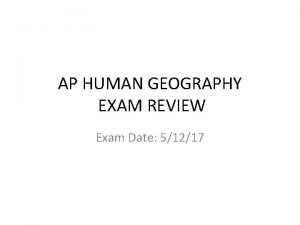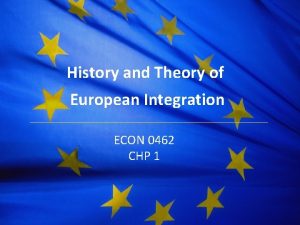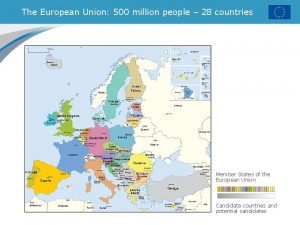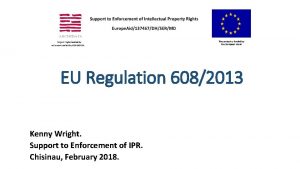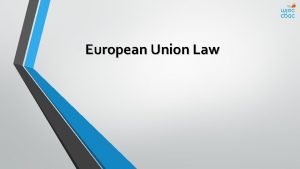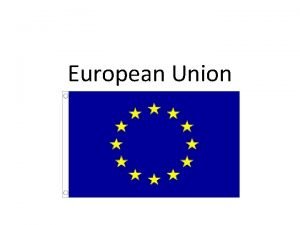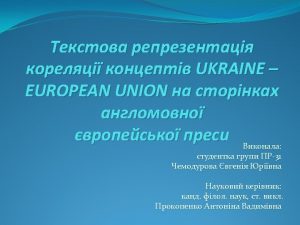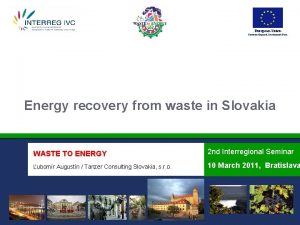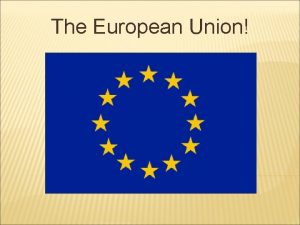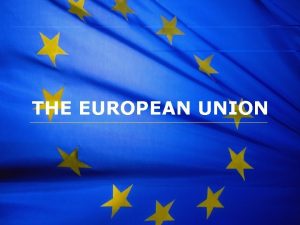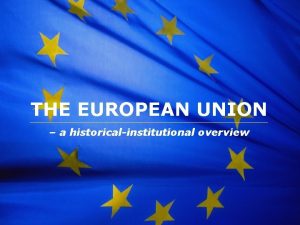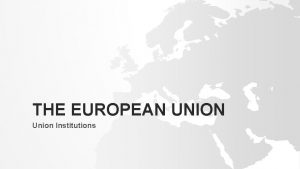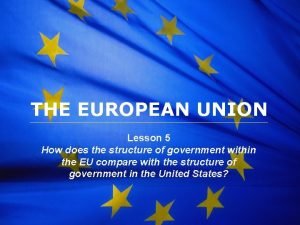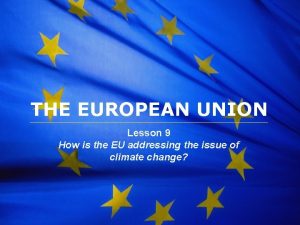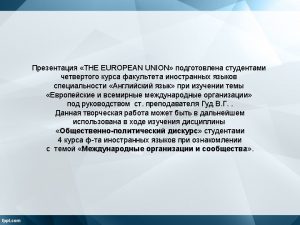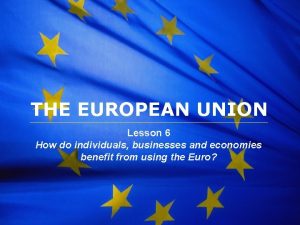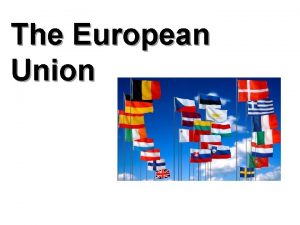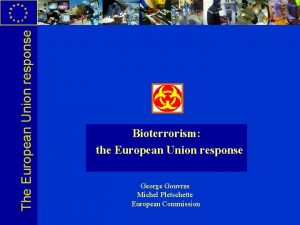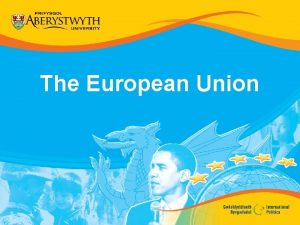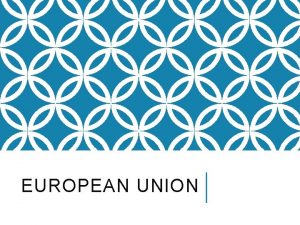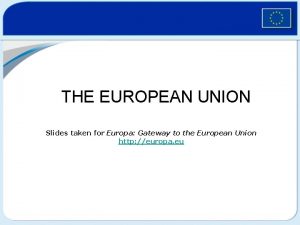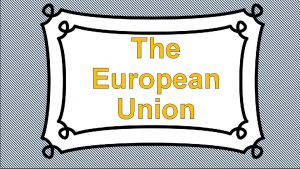THE EUROPEAN UNION WHAT IS THE EUROPEAN UNION














































- Slides: 46

THE EUROPEAN UNION

WHAT IS THE EUROPEAN UNION? • The European Union is a political and economic union between 27 European countries. • The United Kingdom decided to leave the European Union on the 31 st January 2020.

COUNTRIES OF THE EUROPEAN UNION

¿QUÉ ES LA UNIÓN EUROPEA? • La Unión Europea es una unión económica y política de 27 países europeos. • El Reino Unido decidió abandonar la Unión europea el 31 de enero de 2020.

WHEN DID THE EUROPEAN UNION START? • After the 2 nd World War 6 countries signed the Treaty of Paris in 1951 to join together to promote peace and share the coal and steel resources. • 6 founding members: France, Belgium, West Germany, Italy, Luxembourg and the Netherlands.

¿CUÁNDO COMENZÓ LA UNIÓN EUROPEA? • Después de la segunda guerra mundial, 6 países firmaron el tratado de París en 1951 para unirse y promocionar la paz. • También acordaron compartir los recursos del carbón y acero para poder reconstruir sus países después de la guerra. • 6 países miebros: Francia, Bélgica, Alemania Occidental, Italia, Luxemburgo y Holanda.

THE 6 FOUNDING MEMBERS

C. E. C. A= COMUNIDAD EUROPEA DEL CARBÓN Y EL ACERO

WATCH THIS VIDEO ABOUT THE EUROPEAN UNION https: //www. youtube. com/watch? v=j 8 s. Yj. QDU h. KM WRITE TRUE OR FALSE. CORRECT THE FALSE ONES IN YOUR NOTEBOOK. 1. The EU is an international organization made up of 28 countries. 2. The EU started after the World War II. 3. In 1952 6 founding members founded the Coal And Steel Community. 4. The Treaty of Rome established the European Economic Community. 5. Spain, Ireland Denmark joined the EU in 1973. 6. On June 23 rd 2016 British citizens held a referendum to decide if they should leave the EU.

EUROPEAN UNION OBJECTIVES • Aim of the EU: to protect and strengthen the rights and interests of its member states and their citizens. • There are 2 types of objectives: • Political objectives • Economic objectives

OBJETIVOS DE LA UNIÓN EUROPEA • Finalidad de la UE: proteger y fortalecer los derechos e intereses de los estados miembros y de sus ciudadanos. • Hay 2 tipos de objetivos: • Objetivos políticos • Objetivos económicos

POLITICAL OBJECTIVES • There are many… (read page 54 in our book) • Let´s study 3 of them. • To improve working conditions and promote equal opportunities. • To promote democracy and freedom around the world. • To prevent diseases and promote medical research.

OBJETIVOS POLÍTICOS • Hay muchos…(lee la página 44 de nuestro libro) • Vamos a estudiar 3 de ellos. • Mejorar las condiciones laborales y promover la igualdad de oportunidades entre los ciudadanos de los países miembros. • Promover la democracia y libertad por todo el mundo. • Evitar enfermedades y promover la investigación médica.

ECONOMIC OBJECTIVES • There are many…(read page 44 in our book) • Let´s study 3 of them. • To create jobs and promote economic growth. • To develop small businesses and encourage innovation. • To protect EU businesses and allow them to trade freely with other countries.

OBJETIVOS ECONÓMICOS • Hay muchos…(lee la página 44 de nuestro libro) • Vamos a estudiar 3 de ellos. • Crear empleo y promover el crecimiento económico. • Desarrollar la pequeña y mediana empresa e incentivar la innovación. Ayudar a aquellos que quieren abrir un negocio y ayudar a la gente con ideas nuevas y creativas. • Proteger a las empresas y permitir el libre comercio con otros países.

EU SYMBOLS • The euro is the currency of the Eurozone. • Eurozone= countries of the EU that use the euro. Not all the countries have the euro. 8 European countries do not use the euro: Bulgaria, Croacia, Denmark, Hungary, Poland, Czech Republic, Romania and Sweden. The European flag The European anthem Ode to Joy by Beethoven. • •

SÍMBOLOS DE LA UE • El euro es la moneda de la Eurozona es otro nombre para todos los países de la UE que utilizan el euro. • • No todos los países de la UE utilizan el euro. Bulgaria, Croacia, Dinamarca, Hungría, Polonia, República Checa, Rumanía y Suecia NO usan el euro. La bandera de la UE. El himno de la UE: Himno a la alegría de Beethoven. • •

EUROPEAN SYMBOLS

THE EURO Watch this video and answer these questions in your notebook https: //www. youtube. com/watch? v=VOff. Woz. T 4 j. A Questions: How many countries use the euro? What institution issues notes and coins? Where is the European Central Bank? What pictures do the notes show? What 2 sides does the euro coin have?

THE EURO Ve este vídeo y contestas preguntas en tu cuaderno. Puedes ayudarte pinchando en los subtítulos. https: //www. youtube. com/watch? v=VOff. Woz. T 4 j. A Preguntas: ¿cuántos países usan el euro? ¿Qué institución europea fabrica los billetes y monedas? ¿Dónde está el Banco Central Europeo? ¿Qué dibujos muestran los billetes? ¿Cómo son las dos caras de un euro? .

THE EURO • The euro was introduced in 2002. • The name «euro» was chosen by the European Council in a meeting in Madrid in 1995. • The symbol is based on a Greek letter. • Security is important. The notes have watermarks and security threads to stop criminals from making fake money.

EL EURO • El euro se introdujo en 2002. • El nombre de «euro» fue elegido por el Consejo Europeo en una reunión en Madrid en 1995. • El símbolo está basado en una letra griega. • La seguridad es importante. Los billetes tienen marca de agua y bandas de seguridad para impedir la falsificación.

ADOPTING THE EURO • When a country enters the EU, it has to agree to adopt the single currency. • New members need time to meet the economic and legal conditions for adopting the euro. • The Treaty of Maastricht establishes the economic conditions for a country to enter the Eurozone. • The European Commission together with the European Central Bank decide if a country can enter the Eurozone or not. • A country can decide to keep their own currency. This is the case of Denmark.

ADOPTAR EL EURO • Cuando un país entra en la UE, tiene que estar de acuerdo en adoptar el euro como moneda única. • El tratado de Maastricht establece las condiciones económicas para que un nuevo país entre en la Eurozona. • Los nuevos países necesitan tiempo para cumplir todas las condiciones del tratado. • La Comisión Europea y el Banco Central Europeo deciden si un país puede entrar en la Eurozona o no. • Cualquier país puede decidir mantener su moneda. Firma un documento de exclusión ( se queda fuera de la Eurozona). Este es el caso de Dinamarca.

THE EUROPEAN FLAG • It symbolises the identity and Unity of Europe. • It has a circle of 12 gold stars on a blue blackground. • The stars represent the ideals of unity, solidarity and harmony among the peoples of Europe.

LA BANDERA EUROPEA • Simboliza la identidad y unidad de Europa. • Tiene un círculo de 12 estrellas doradas en un fondo azul. • Las estrellas representan los ideales de unidad, solidaridad y armonía entre los pueblos de Europa.

EUROPEAN INSTITUTIONS INSTITUTION WHERE IS IT? FUNCTION COUNCIL OF THE E U BRUSSELS (BELGIUM) IT PASSES LAWS IT APPROVES BUDGETS IT SIGNS AGREEMENTS WITH NON-EUROPEAN COUNTRIES

INSTITUCIONES EUROPEAS INSTITUCIÓN DÓNDE ESTÁ FUNCIÓN CONSEJO DE LA UE BRUSELAS (BÉGICA) APRUEBA LEYES APRUEBA PRESUPUESTOS FIRMA ACUERDOS CON PAÍSES FUERA DE LA UE

EUROPEAN INSTITUTIONS INSTITUTION WHERE IS IT? FUNCTION EUROPEAN PARLIAMENT STRASBOURG (FRANCE) IT DEBATES AND PASSES LAWS IT APPROVES BUDGETS WITH THE COUNCIL OF THE EU

INSTITUCIONES EUROPEAS INSTITUCIÓN DÓNDE ESTÁ FUNCIÓN PARLAMENTO EUROPEO ESTRASBURGO (FRANCIA) DEBATE Y APRUEBA LEYES APRUEBA PRESUPUESTO S JUNTO CON EL CONSEJO DE LA EU

EUROPEAN INSTITUTIONS INSTITUTION WHERE IS IT? FUNCTION EUROPEAN COMMISSION BRUSSELS (BELGIUM) IT MAKES NEW LAWS. IT SPENDS EU FUNDS

INSTITUCIONES EUROPEAS INSTITUCIÓN ¿DÓNDE ESTÁ? FUNCIÓN COMISIÓN EUROPEA BRUSELAS (BÉLGICA REDACTA NUEVAS LEYES GASTA LOS FONDOS DE LA UE

EUROPEAN INSTITUTIONS INSTITUTION WHERE IS IT? FUNCTION EUROPEAN COUNCIL BRUSSELS (BELGIUM) IT DISCUSSES POLITICAL ISSUES IT HAS NO POWER TO MAKE LAWS

INSTITUCIONES EUROPEAS INSTITUCIÓN ¿DÓNDE ESTÁ? FUNCIÓN CONSEJO EUROPEO BRUSELAS (BÉLGICA) DEBATE TEMAS POLÍTICOS NO HACE LEYES

EUROPEAN INSTITUTIONS INSTITUTION WHERE IS IT? COURT OF LUXEMBOURG JUSTICE OF THE EU FUNCTION IT ENSURES ALL MEMBER STATES APPLY EU LAWS IN THE SAME WAY.

INSTITUCIONES EUROPEAS INSTITUCIÓN ¿DÓNDE ESTÁ? FUNCIÓN TRIBUNAL DE JUSTICIA DE LA UE LUXEMBURGO SE ASEGURA DE QUE TODOS LOS PAÍSES MIEMBROS APLIQUEN LAS LEYES DE LA MISMA MANERA.

EUROPEAN INSTITUTIONS INSTITUTION WHERE IS IT? FUNCTION EUROPEAN COURT OF AUDITORS LUXEMBOURG IT INVESTIGATES HOW MONEY IS INVESTED. IT PRESENTE AUDITS TO THE EUROPEAN COMMISSION

INSTITUCIONES EUROPEAS INSTITUCIÓN ¿DÓNDE ESTÁ? FUNCIÓN TRIBUNAL DE CUENTAS EUROPEO LUXEMBURGO INVESTIGA CÓMO SE GASTA EL DINERO PRESENTA LAS CUENTAS A LA COMISIÓN EUROPEA

EUROPEAN INSTITUTIONS INSTITUTION WHERE IS IT? FUNCTION EUROPEAN CENTRAL BANK FRANKFURT (GERMANY) IT KEEPS PRICE STABLE IN THE 19 COUNTRIES THAT HAVE THE EURO PRESIDENT CHRISTINE LAGARDE IT DECIDES THE ECONOMIC POLICY OF THE EU FOUNDED IN 1998 IT SUPERVISES THE BANKS

INSTITUCIONES INSTITUCIÓN ¿DÓNDE ESTÁ? FUNCIÓN EUROPEAS BANCO CENTRAL EUROPEO FRANKFURT (ALEMANIA) MANTIENE LA ESTABILIDAD DE PRECIOS EN LOS 19 PAÍSES QUE TIENEN EL EURO PRESIDENTA CHRISTINE LAGARDE DECIDE LA POLÍTICA ECONÓMICA DE LA UE FUNDADO EN 1998 SUPERVISA LOS BANCOS CENTRALES DE LOS 19 PAÍSES


INSTITUCIONES EUROPEAS Consejo de la Unión Europea en Bruselas El Parlamento Europeo en Estrasburgo

INSTITUCIONES EUROPEAS TRIBUNAL DE JUSTICIA EN LUXEMBURGO BANCO CENTRAL EUROPEO EN FRANKFURT (ALEMANIA)

WATCH THIS VIDEO https: //www. youtube. com/watch? v=yw. JS 7 swbqe. E WARNING!! This video was made before the Brexit, so they say « 28» members, but you know we are « 27» CHOOSE THE RIGHT OPTION. THEN COPY THE CORRECT SENTENCE IN YOUR NOTEBOOK. 1. The European Commission is…. a) Political b)economic c)judicial 2. The European Parliament is based in… a) Luxembourg b)Strassbourg c)Brussels 3. There are…MEPs a)800 b)750 c)751 4. The Council of the European Union is where the 27 member countries… a)Vote b)reject laws c)make a deal 5. The European Court of Justice is in…. a)Luxembourg b)Strassbourg c)Brussels

A SINGLE MARKET • The single market started in Europe in 1986. • There is a common law for trade. • In 1993 internal border controls were removed. • Goods, money , people and services can move freely. • https: //www. youtube. com/watch? v=1 XWOWddn 5_4

UN MERCADO ÚNICO • El mercado único empezó en Europa en 1986. • Hay una ley única para el comercio. • En 1993 las fronteras entre países miembros desaparecieron. • Mercancías, dinero, personas y servicios se mueven libremente por la UE.
 Union union all intersect
Union union all intersect The european institutions
The european institutions This project is funded by the european union
This project is funded by the european union European union 28 countries
European union 28 countries European taekwondo union
European taekwondo union This project is funded by the european union
This project is funded by the european union Co-funded by the erasmus+ programme of the european union
Co-funded by the erasmus+ programme of the european union This project is co-funded by the european union
This project is co-funded by the european union This project is funded by the european union
This project is funded by the european union European union military
European union military Eurostars-3
Eurostars-3 This project is funded by the european union
This project is funded by the european union Co-funded by the erasmus+ programme of the european union
Co-funded by the erasmus+ programme of the european union Co-funded by the erasmus+ programme of the european union
Co-funded by the erasmus+ programme of the european union Range definition ap human geography
Range definition ap human geography European union history
European union history Giorgi kacharava
Giorgi kacharava European union 28 countries
European union 28 countries This project is funded by the european union
This project is funded by the european union Direct effect eu law
Direct effect eu law Sơ đồ cơ thể người
Sơ đồ cơ thể người Bảng số nguyên tố lớn hơn 1000
Bảng số nguyên tố lớn hơn 1000 đặc điểm cơ thể của người tối cổ
đặc điểm cơ thể của người tối cổ Tia chieu sa te
Tia chieu sa te Các châu lục và đại dương trên thế giới
Các châu lục và đại dương trên thế giới Chụp phim tư thế worms-breton
Chụp phim tư thế worms-breton ưu thế lai là gì
ưu thế lai là gì Tư thế ngồi viết
Tư thế ngồi viết Cái miệng nó xinh thế chỉ nói điều hay thôi
Cái miệng nó xinh thế chỉ nói điều hay thôi Các châu lục và đại dương trên thế giới
Các châu lục và đại dương trên thế giới Mật thư anh em như thể tay chân
Mật thư anh em như thể tay chân Bổ thể
Bổ thể Tư thế ngồi viết
Tư thế ngồi viết Thứ tự các dấu thăng giáng ở hóa biểu
Thứ tự các dấu thăng giáng ở hóa biểu Thẻ vin
Thẻ vin Thơ thất ngôn tứ tuyệt đường luật
Thơ thất ngôn tứ tuyệt đường luật Chúa yêu trần thế
Chúa yêu trần thế Hổ sinh sản vào mùa nào
Hổ sinh sản vào mùa nào Từ ngữ thể hiện lòng nhân hậu
Từ ngữ thể hiện lòng nhân hậu Diễn thế sinh thái là
Diễn thế sinh thái là Vẽ hình chiếu vuông góc của vật thể sau
Vẽ hình chiếu vuông góc của vật thể sau 101012 bằng
101012 bằng Tỉ lệ cơ thể trẻ em
Tỉ lệ cơ thể trẻ em Lời thề hippocrates
Lời thề hippocrates Vẽ hình chiếu đứng bằng cạnh của vật thể
Vẽ hình chiếu đứng bằng cạnh của vật thể đại từ thay thế
đại từ thay thế
